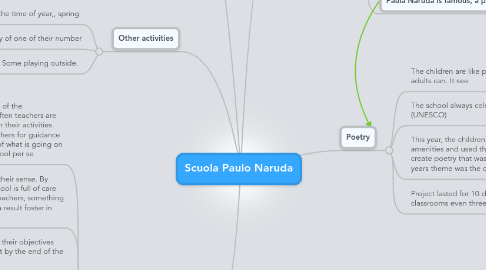Scuola Paulo Naruda
Nick Packardにより

1. Other activities
1.1. Some studying the time of year,, spring
1.2. Some celebrating the birthday of one of their number
1.3. Some playing outside.
2. In the classrooms
2.1. Construction.... Not a single piece of something specifically designed to construct anything with, loads of real materials, beautiful space defined by a large wooden chest, three children working with such focus to construct something on a scale we wouldn't normally have in an everyday experience. There relatively low levels of conversation and it's all child-directed but the collaboration is still very high, well, complete, really.
2.2. In y3s, platform for role playin classroom, platform must've 2 m up at least... Is this an H&S issue?
2.3. Relatively few individual activities going on, almost everything is collaborative, big sheets of paper with three children drawing, light table where four children work side by side. Large construction again, defined space on a pedestal, only the clay work and the painting were individual responses. Not sure of stimulus toll this though.
2.4. Platforms in classrooms to provide new perspectives and spaces.
2.5. Atelier in the ceiling space, use of roof lights and lots of natural light.
2.6. Outdoor spaces, not amazingly well resourced but active, peaceful (othe whole). Lots of resources brought out rather than in situ
2.7. Still with the 6 year olds, writing is relatively free. There are prompts to 'write well but many are still using capital letters only, writing chest under the stairs provides some opportunities but still see no real sense of requiring children to write.
3. Discussions and points arising
3.1. Part of the children's sense of ownership of the school/space comes from the fact that often teachers are present but not necessarily intervening in their activities. As such, the children do not look to teachers for guidance so do not see the teachers as 'owners ' of what is going on in school, and perhaps therefore the school per se
3.2. How do you teach children to ,care, in their sense. By modelling it, the atmosphere in the school is full of care and it is a perpetual objective for the teachers, something they continually strive to foster and as a result foster in the children.
3.3. This speaks to the fact that in the school their objectives for learning are met over three years, not by the end of the week!
3.4. We have to remember that much of this philosophical discussion is based in a belief about it's value. We don't have the same cultural context and must make sure we don't get carried away with the idea that all this works for us...
3.5. Small groups foster details but large groups assimilate meaning
3.6. More importantly, the group times are the times when the sense of community in all it's facets is developed. Some carefully supported but mostly incidental -such as in the piazza.
3.7. You notice again how every member of staff talks about the philosophy of the approach in rich detail. What matters here is not knowledge of strategies for teaching specifi ideas or skills but the capacity to foster this sense of communit and care for ideas and people.
4. About the school
4.1. School founded in the 70's
4.2. Pre school, 3 to 6 years
4.3. The 'fruit of an act of solidarity, linked to sculls Robinson (following fire, the kids from Robinsonscame here and the next year the children returned to Robinsosnbut the school stayed.
4.4. Here, the stairs are the school's piazza
4.5. Not purpose built like other school in Reggio - so finding out how the pedagogy and the schoo work together has been somethingof an investigation. Some restructure in the90's
4.6. Paula Naruda is famous, a poet and a freedom activist
5. Poetry
5.1. The children are like poets. Ecause they can see things that adults can. It see
5.2. The school always celebrates the international day of poet (UNESCO)
5.3. This year, the children went into the city and local amenities and used the inspirations of these spaces to create poetry that was then donated bro the community. This years theme was the onion.
5.4. Project lasted for 10 days but is still ongoing in some classrooms even three weeks later.


